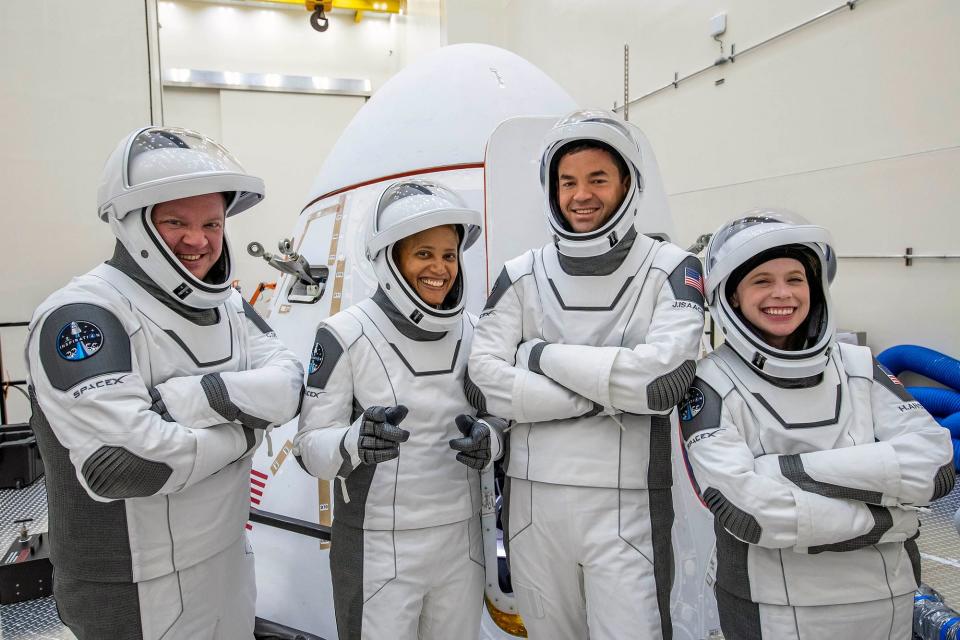SpaceX to Launch Inspiration4 Mission With Civilians Next Week: Meet Soon-To-Be Astronauts

Elon Musk's SpaceX to send its first all-civilian crew to orbit on a three-day mission around the Earth next week.
British billionaire Richard Branson's Virgin Galactic and Jeff Bezos' Blue Origin recent travel to space, as per some experts, did not reach space but touched the edge of the space.
Next week, Elon Musk's SpaceX will send its first all-civilian crew to orbit on a three-day mission around the Earth. When the Crew Dragon spacecraft will be launched into space by Falcon 9 on 15 September as part of the Inspiration4 mission, four private individuals will be stowed within.
While confirming the news Inspiration4 tweeted: "#Inspiration4 and @SpaceX have completed our flight readiness review and remain on track for launch!"

The Inspiration4 campaign intends to earn more than $200 million for St. Jude Children's Research Hospital in Memphis, Tennessee that is dedicated to curing childhood cancer and other diseases in children.
The launch will take place at NASA's Kennedy Space Center at Cape Canaveral, Florida. The Dragon spacecraft is aiming for a height of 335 miles, which would put it roughly 75 miles above the International Space Station (ISS) and on a level with the Hubble Space Telescope.
The soon-to-be astronauts—Jared Isaacman, Chris Sembroski, Hayley Arceneaux and Dr Sian Proctor—are set to arrive in Florida on 9 September to begin flight preparations after months of hard training since their selection in March this year. According to Inspiration4, their preparation included "centrifuge training, Dragon simulations, observations of prior SpaceX launch operations, Zero-G plane training, altitude training and more classroom, simulation and medical testing."
The 38-year-old Isaacman, who is the founder and CEO of credit card processing startup Shift4 Payments and a skilled jet pilot, will lead the mission. He has not disclosed the cost of the flight, but he has donated $100 million to St. Jude's. According to Forbes, Isaacman has an estimated net worth of $2.6 billion.
"The tie-in with St. Jude was just an instantaneous connection. The moment I knew that I was going to have the opportunity to go on this adventure, then immediately [came] the obligation of trying to achieve more good than what the mission itself hopes to accomplish," he said.
Two of the mission's seats were donated by Isaacman, with one reserved for a St. Jude ambassador with direct ties to this mission. Isaacman introduced his team in March, which included 29-year-old Arceneaux, who was diagnosed with bone cancer as a youngster at St. Jude's and was employed by the hospital last spring.
Arceneaux will be the medical officer for the crew. She will become the youngest American in space as a result of the trip, surpassing NASA record-holder Sally Ride by more than two years. She earlier stated that her battle with cancer prepared her for space travel. Additionally, she said: "It made me tough and then also I think it really taught me to expect the unexpected and go along for the ride."
The 51-year-old Proctor works as an instructor at a community college in Tempe, Arizona. She won a contest sponsored by Isaacman's Shift4Shop eCommerce platform, which sought inspirational entrepreneurs who deserved to be "elevated to the stars". Proctor's father served at the NASA tracking station during the Apollo missions and he is an analogue astronaut.
The other civilian, 41-year-old Sembroski, a Lockheed Martin engineer from Everett, Washington. He received the second of Isaacman's donated seats. It was his friend who initially won the sweepstakes, which resulted in over 72,000 donations totalling $13 million to St. Jude's. But, Sembroski was called in to fill in for the unnamed friend who was unable to fly due to personal circumstances.
Both the Dragon crew capsule and the reusable SpaceX's Falcon 9 rocket have flown before, but the 16 September has been established as a backup launch date. According to the plan, before splashing down in the Atlantic Ocean, the crew will orbit the Earth for three days.
In March, Isaacman said: "Inspiration4's goal is to inspire humanity to support St. Jude here on Earth while also seeing new possibilities for human spaceflight. Each of these outstanding crew members embodies the best of humanity, and I am humbled to lead them on this historic and purposeful mission and the adventure of a lifetime."
However, like SpaceX, British billionaire Richard Branson's Virgin Galactic and Amazon.com Inc. founder Jeff Bezos' Blue Origin are also focusing on the space travel business and recently launched two flights to become first billionaires into the space. After the recent launch events, the Virgin Galactic mission to space with civilians achieved an altitude of 86 kilometres, while the Blue Origin flight passed the 62-mile (almost 100 kilometres)—and this is where the controversy started about their achievements.
The Kármán line, which is 100 kilometres above sea level, is the most widely accepted space border. However, in the United States, the cutoff point is set at 80 kilometres. According to aerospace pioneer Theodore von Kármán: "This is certainly a physical boundary, where aerodynamics stops and astronautics begins… Below this line, space belongs to each country. Above this level, there would be free space."
These two billionaires may not be called "astronauts" as the United States has tightened its definition of the word. According to new Federal Aviation Administration (FAA) regulations, astronaut candidates must be a member of the flight crew and contribute to space flight safety. Apart from the altitude, it was also stated that potential astronauts must have "demonstrated activities during flight that were essential to public safety, or contributed to human space flight safety".
So, some experts have claimed that both Bezos and Branson, as well as crew members, did not reach the space but touched the edge of the space. On the other hand, in the case of SpaceX's scheduled mission, these civilians will not only reach the space crossing the boundary but also will orbit the Earth for three days.

